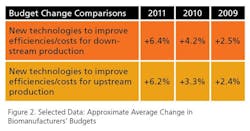Overall and as expected (as with most industries), as shown in Figure 4, biopharmaceutical industry outsourcing today remains largely preoccupied with lower value-added tasks, particularly testing services. When asked about areas with any current outsourcing, the highest response, 70.0%, was for product characterization—e.g., pre-release testing. This was followed by validation testing services (69.3%), plant maintenance (67.1%), toxicity testing (65%), and analytical testing and bioassays (60.7%).In terms of manufacturing, fill and finishing had the higher percentage (60.7%). The areas with the least outsourcing were Design of Experiments (DOE), only 20.7% and downstream (22.1%) and upstream (23.6%) process development. However, more companies are considering these more critical tasks, and may be ready to trust higher value activities to others. This increased sophistication means companies are now evaluating factors including speed-to-market, increased flexibility of operations, and placing remaining employees in higher-value positions to build more strategic corporate infrastructure. Current trends in biopharmaceutical outsourcing indicate the future will increasingly include manufacture of commercial products, not just R&D and trial supplies. CMOs with the most established, broad and sophisticated services, including having the infrastructure and in-house expertise to prepare product applications and perform commercial cGMP manufacture, will be the biggest winners in terms of gaining new commercial manufacturing business.
The Rise of Single-use BioprocessingSingle-use bioprocessing equipment, generally composed of plastics rather than stainless steel, is providing the biopharmaceutical industry with cost-effectiveness and flexibility. Single-use bioreactors and other equipment are ultimately cheaper than stainless steel and provide greater flexibility, including the ability to purchase, ship, store and install complete manufacturing systems as needed. Combine this flexibility with reduction in the cost of manufacturing infrastructure (no need for steam/clean/sterilize equipment for reuse), and the use of single-use bioprocessing equipment is increasingly a necessity to remain competitive, especially as biosimilars continue their push onto the global markets. Our survey this year shows that the average company is currently spending about $1 million/year for purchase of single-use systems, with 68.1% of survey respondents reporting current in-house use of single-use bioreactors. However, no mainstream biopharmaceutical product is yet manufactured using a single-use bioreactor-based system. This is primarily due to the relative newness of single-use bioreactors. Single-use (particularly upstream) bioprocessing systems now dominate R&D and clinical supplies (pre-market) manufacturing worldwide.Regulatory uncertainties, however, remain regarding cGMP commercial manufacturing using plastic vs. stainless steel equipment. Once a few companies pioneer FDA and other highly-regulated approvals of products manufactured using single-use systems, these devices will likely compete aggressively in commercial manufacturing against fixed, expensive, stainless steel systems. Single-use equipment may ultimately place cost pressures on contract manufacturers. As bioprocessing becomes simpler and less expensive, more will consider in-house manufacturing. But single-use bioprocessing also make production simpler and cheaper for CMOs as well. Currently, CMOs appear to be winning, with single-use equipment tending to make their services more attractive, particularly as they develop increased expertise from repeated use of single-use systems. The biopharmaceutical industry is well aware that, in general, bioprocessing systems and bioreactors have changed little over many decades. Our survey shows that the industry is actively seeking innovations and improvements in bioprocessing systems, particularly single-use systems which offer the most savings and advantages. Improvements in bioreactors, particularly single-use, ranked along with purification equipment as the areas where bioprocessing innovations were reported as most needed, with 29.2% of respondents citing bioreactors. Bioreactors also continued as the area taking up the largest portion of companies’ bioprocessing budgets.Among the 186 vendors and suppliers we surveyed, single-use bioreactors were the area where the largest portion, 40.5%, reported working, at least in some way, on new technologies and products. Thus, improvements and innovations can be expected in coming years.A trend in bioprocessing technology to watch is the development and adoption of perfusion bioreactors, which appear on track to revolutionize biopharmaceutical manufacturing. Perfusion bioreactors involve cells growing at up to 1,000 times higher concentration than batch-fed bioreactors; they require less space and offer related cost savings. Perfusion is not new, with a number of companies offering these bioreactors back in the 1970s and 1980s, mostly for hybridoma (monoclonal antibody) culture, but these were abandoned when recombinant manufacturing became dominant in the 1980s and 1990s.
Biosimilars: More Products, More CompaniesPerhaps the most disruptive emerging trend involves the introduction of biosimilar products (including biogenerics and biobetters). As these are introduced, they may significantly increase the number of drug products and companies in coming years. Last year, the U.S. joined other major market countries in establishing a biosimilar approval mechanism, although it will take FDA a few more years to fully implement. Already, over a dozen biosimilars have been approved in the European Union.Compared to generic drugs, biosimilars are likely to be much less of a threat to established manufacturers. Unlike generic drugs, few true biogenerics (i.e., products presumed to be the same, with automatic substitution for their reference products allowed) will be approved in the U.S. and other major markets in coming years. Most highly-regulated countries expect to have difficulties with approvals of biosimilars, which are not presumed to be identical for prescription purposes. And price discounts by biosimilars will be much smaller, because biologics tend to be more expensive to manufacture than generic small-molecule drugs. Thus, biosimilars will not dramatically disrupt established biopharmaceutical markets the way generic small molecule drugs have done. Despite this, biosimilars will result in a significant expansion of the number of biopharmaceutical products and companies. For every successful product coming off-patent, there will likely be multiple biosimilars in the marketplace. This will result in an increase in biopharmaceutical manufacturers and marketers worldwide, and a higher demand for experienced staff, equipment, and management. Further, biosimilars are seen by many companies, including generic drug and foreign companies, as a relatively easy way to enter the U.S. and other major markets. This includes a number of companies in India and China likely to seek approval of biosimilars in the U.S. and other major markets. However, getting biosimilars to the market will not be an easy task. With few precedents, regulatory approvals are not assured. Other threats to biosimilars could include older reference products being withdrawn from the market, or replaced, as biosimilar competition approaches. This may make comparative testing difficult, resulting in the need for clinical trials for biosimilar approval. As a result, the biosimilar version may require a full approval, involving higher expenses. Other problems for biosimilars include there simply being too many competing products. With companies seeing biosimilars as a way to enter major markets, competitive pressures may disrupt markets and reduce profitability.
SummaryTrends in biologics today point toward increased growth and profitability, in contrast with some mainstream small-molecule-oriented pharmaceutical industry segments. Major trends affecting the biopharmaceutical industry include increasing company budgets; the adoption of single-use/disposable equipment and other bioprocessing advances that improve cost-savings, quality, productivity, and flexibility in manufacturing; and the advent of biosimilars increasing in the number of biopharmaceutical products and companies present in the market in coming years. There are currently about 425 biopharmaceuticals in the major U.S. and European Union markets. And there are around 60 product applications either pending or expected to soon be filed with FDA [2]. With ever-increasing knowledge, technological advances, successful products and companies, and improving manufacturing economics, biopharmaceuticals are a bright spot within the pharmaceutical industry. Biopharmaceuticals currently provide around 15% of pharmaceutical industry revenue. This will increase rapidly in coming years, with an estimated 40% of pharmaceuticals currently in development being biopharmaceuticals.
About the AuthorEric S. Langer is president and managing partner at BioPlan Associates, Inc., a Rockville, MD-based biotechnology and life sciences marketing research and publishing firm established in 1989. He can be reached at [email protected] or 301-921-5979.References1. Langer, E., 8th Annual Report and Survey of Biopharmaceutical Manufacturing Capacity and Production: BioPlan Associates, April 2011, 490 pages, www.bioplanassociates.com.2. Rader, R.A., BIOPHARMA: Biopharmaceutical Products in the U.S. and European Markets, online database, www.bioplanassociates.com/biopharma.



